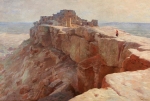William R. Leigh was born in Berkeley County, West Virginia in 1866. Deciding upon a career in art quite early, Leigh enrolled in classes at the Maryland Institute, Baltimore, in 1880, spending three years there before moving to Munich shortly before his 17th birthday. He studied at the Royal Academy for more than a decade, leaving in 1895. While at the academy, he won the annual medal for painting six times consecutively.
Returning to the United States, Leigh settled in New York City, where he made illustrations for Scribner’s and Collier’s magazines. He became well-established as an illustrator, but both the nature of the work and the limited subject matter made him anxious for new challenges. In 1906, an opportunity to expand the scope of his work came about when the Santa Fe Railroad offered him free passage to the West in exchange for a painting of the Grand Canyon. Leigh accepted the offer and, at age 40, set off through New Mexico and Arizona. The trip yielded not just the Grand Canyon piece he had been commissioned to do, but also five additional canvases that were purchased by the railroad.
His focus was on the changing light of the Southwest, the pinks and purple hues that characterize sunsets over the mountain ranges of Arizona and New Mexico. His use of European techniques in painting large-scale images of the American West eventually earned him the nickname “America’s Sagebrush Rembrandt.”
Leigh traveled throughout the West, painting the Grand Canyon, the Rockies of Wyoming and Yellowstone. However, his primary subjects were the Hopi and Navajo Indians, whom he painted every summer from 1912 to 1926. In 1926, he took the first of two trips to Africa, though African subjects never permeated his work as thoroughly as Southwestern subjects.
A successful illustrator for much of his career, Leigh started to experience real success as a fine artist starting in the early 1940s.
Gilcrease Museum owns one of the largest collections of works by Leigh, numbering nearly 1,300 pieces. This collection is particularly interesting as it includes the contents of Leigh’s studio, which were gifted to Gilcrease by the artist’s widow after his death in 1955, along with paintings and the artist’s studies.
The New York Herald Tribune called Leigh “the last surviving member of the famous western painting trio that included Frederic Remington and Charles Russell.”
Although Leigh’s paintings are well known, his studies have rarely been on display. They provide an intimate look into the artistic process, depicting the most minor evolutions to his compositions and, in a number of cases, showcase the effort Leigh put into perfecting his illustrations and paintings.
Organized by Gilcrease Museum and guest curator, Holbrook C. Lawson, Showing the Hand of the Artist: The Sketches of William R. Leigh will run through June 26, 2016.





